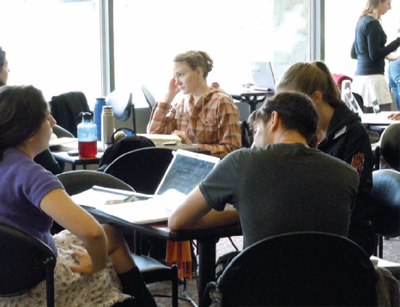From 'Shh…' to [Click]
In the digital age, libraries face big changes— and tough decisions

Since the earliest days of higher education, the library has functioned as a campus's central information and study hub. But with advances in technology, the role of the University Library is changing fast. With 24/7 Internet access through smartphones, laptops, and computer labs throughout campus, college students have an immense wealth of information at their fingertips—meaning that much of the information once housed solely in the physical space of the libraries is now available in cyberspace. "Rather than having to come here and use a physical card catalog, students can access our catalog remotely, or they can find the materials through a Google search or other mechanisms," says Dean Krafft, PhD '81, the libraries' chief technology specialist. "We also license a huge number of scholarly articles and resources that students can access directly from their computers."
If students are stuck, they can text or instant message a librarian for help, while services like BorrowDirect link Cornell's physical collection with those of other universities around the country, so that nearly any book is available on campus in less than five days. And there are multiple projects currently under way to digitize the University archives and periodicals, as well as many of the libraries' special collections. Combined with the fact that wireless Internet access and computer labs are available throughout campus, fewer and fewer students feel the need to set foot in the library.
Take Dave Rodriguez, a sophomore in the College of Engineering. The applied and engineering physics major from Long Island can hardly recall the last time he went to the library. "Pure silence kind of creeps me out," he explains, "so I feel more comfortable working at home." While in the past students might have had to leave the comfort of their apartments to conduct research or check out books, Rodriguez can easily do all of his work remotely. His Collegetown apartment's wireless connection allows him to access all the information he needs on his MacBook Pro, making trips to campus largely unnecessary.
As student needs have evolved, the library has changed as well. Computers now take up a large portion of the physical space, and cubicles and desks come equipped with outlets for laptops. Students can check the availability of books online without venturing into the stacks—and with the electronic budget accounting for 30 to 40 percent of the library's overall expenditures, tough decisions are being made about the future of the physical collections. Last year head librarian Anne Kenney made the controversial decision to sell the duplicate undergraduate collection to free up funds for new titles, and the physical collections of the Johnson School, Hotel school, and ILR libraries are in the process of being consolidated.
Kenney stresses that although the library now sees more online traffic than physical, students still need a quiet space to work. "I've asked students why they come to the library when they can study anywhere," says Kenney. "They say that it focuses the mind—when you come in, you are here to do serious work." So while the definition of what a library is may be changing, the demand for such a space will likely always exist. "It's no longer the little old lady with glasses saying 'shh' behind the desk," says Krafft, who notes that the very fact that the library employs a chief technology specialist is evidence of how it has changed. "But it's still about preserving knowledge and making it accessible to the community."


